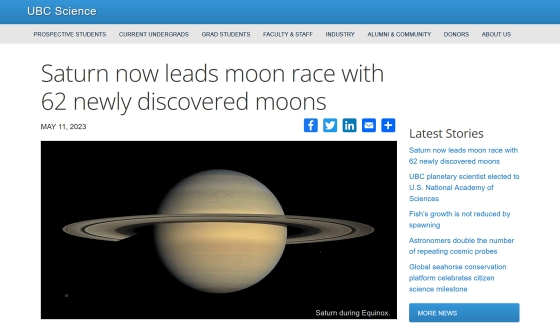62 new satellites of Saturn are discovered, totaling 145, surpassing Jupiter and returning to the seat of ``the planet with the most satellites in the solar system''

An international research team such as
Saturn now leads moon race with 62 newly discovered moons | UBC Science - Faculty of Science at the University of British Columbia
https://science.ubc.ca/news/saturn-now-leads-moon-race-62-newly-discovered-satellites

Scientists discover 62 new moons around Saturn, raising total to 145 — the most in the solar system | Live Science
https://www.livescience.com/space/saturn/scientists-discover-62-new-moons-around-saturn-raising-total-to-145-the-most-in-the-solar-system
Saturn regains status as planet with most moons in solar system | Saturn |
https://www.theguardian.com/science/2023/may/12/saturn-regains-status-as-planet-with-most-moons-in-solar-system
In February 2023, a team at the Carnegie Institute in the United States reported that ``12 new satellites orbiting Jupiter were discovered,'' surpassing the previous record of 83 Saturn and having the most satellites in the solar system. became a planet. Jupiter's satellites have been added since then, and it is said that it has 95 satellites at the time of writing the article.
However, a research team at the University of British Columbia reported that they discovered 62 new moons of Saturn. This brings Saturn's total number of moons to 145, once again surpassing Jupiter's, making it the most in the solar system.

An international research team analyzed data observed by
To identify satellites that were previously unseen because they were too small or too dark, the researchers used a technique called the ' shift-stack method, ' which superimposes a number of successive images taken over a period of three hours. bottom. After matching objects detected on different nights over two years, the research team discovered 62 new satellites. It seems that some of the satellites discovered this time included very small satellites with a width of only 2.5 km.
Edward Ashton, who started research while enrolled at the University of British Columbia and is a postdoctoral researcher at the Institute of Astronomy and Astrophysics, Taiwan at the time of writing the article, said, ``If you are tracking Saturn's moon, It reminds me of the 'connect the dots' game, because you have to connect these various aspects of the moon in your data to a feasible orbit, but there are about 100 different games on the same page. I don't know which point belongs to which puzzle.'

All 62 newly discovered satellites are of the type called irregular satellites , which have elliptical orbits far from the planet or orbits retrograde to the planet's rotation.
Saturn's irregular moons are divided into several groups based on their orbital inclinations, and named after Norse , Gaul , and Inuit mythology, respectively. The satellites discovered this time will eventually be named after these myths.
A group of Saturn's irregular moons with similar orbits are thought to be derived from a larger moon that collapsed about 100 million years ago. Brett Gladman, an astronomy professor at the University of British Columbia, said: 'As we push the limits of modern telescopes, we show that a medium-sized moon that orbited Saturn in the opposite direction was blown away about 100 million years ago. The evidence is growing,' he said.
Related Posts:
in Science, Posted by log1h_ik







